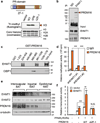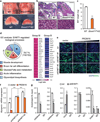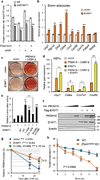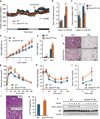EHMT1 controls brown adipose cell fate and thermogenesis through the PRDM16 complex
- PMID: 24196706
- PMCID: PMC3855638
- DOI: 10.1038/nature12652
EHMT1 controls brown adipose cell fate and thermogenesis through the PRDM16 complex
Abstract
Brown adipose tissue (BAT) dissipates chemical energy in the form of heat as a defence against hypothermia and obesity. Current evidence indicates that brown adipocytes arise from Myf5(+) dermotomal precursors through the action of PR domain containing protein 16 (PRDM16) transcriptional complex. However, the enzymatic component of the molecular switch that determines lineage specification of brown adipocytes remains unknown. Here we show that euchromatic histone-lysine N-methyltransferase 1 (EHMT1) is an essential BAT-enriched lysine methyltransferase in the PRDM16 transcriptional complex and controls brown adipose cell fate. Loss of EHMT1 in brown adipocytes causes a severe loss of brown fat characteristics and induces muscle differentiation in vivo through demethylation of histone 3 lysine 9 (H3K9me2 and 3) of the muscle-selective gene promoters. Conversely, EHMT1 expression positively regulates the BAT-selective thermogenic program by stabilizing the PRDM16 protein. Notably, adipose-specific deletion of EHMT1 leads to a marked reduction of BAT-mediated adaptive thermogenesis, obesity and systemic insulin resistance. These data indicate that EHMT1 is an essential enzymatic switch that controls brown adipose cell fate and energy homeostasis.
Figures




Comment in
-
An enzymatic chromatin switch that directs formation of active brown fat.Cell Metab. 2014 Jan 7;19(1):3-4. doi: 10.1016/j.cmet.2013.12.011. Cell Metab. 2014. PMID: 24411935
Similar articles
-
An enzymatic chromatin switch that directs formation of active brown fat.Cell Metab. 2014 Jan 7;19(1):3-4. doi: 10.1016/j.cmet.2013.12.011. Cell Metab. 2014. PMID: 24411935
-
Rorα deficiency and decreased adiposity are associated with induction of thermogenic gene expression in subcutaneous white adipose and brown adipose tissue.Am J Physiol Endocrinol Metab. 2015 Jan 15;308(2):E159-71. doi: 10.1152/ajpendo.00056.2014. Epub 2014 Nov 25. Am J Physiol Endocrinol Metab. 2015. PMID: 25424999
-
Activation of classical brown adipocytes in the adult human perirenal depot is highly correlated with PRDM16-EHMT1 complex expression.PLoS One. 2015 Mar 26;10(3):e0122584. doi: 10.1371/journal.pone.0122584. eCollection 2015. PLoS One. 2015. PMID: 25812118 Free PMC article.
-
Role of PRDM16 in the activation of brown fat programming. Relevance to the development of obesity.Histol Histopathol. 2013 Nov;28(11):1411-25. doi: 10.14670/HH-28.1411. Epub 2013 Jun 17. Histol Histopathol. 2013. PMID: 23771475 Review.
-
Brown adipose tissue: the molecular mechanism of its formation.Nutr Rev. 2009 Mar;67(3):167-71. doi: 10.1111/j.1753-4887.2009.00184.x. Nutr Rev. 2009. PMID: 19239631 Review.
Cited by
-
Recognition of H3K9 methylation by GLP is required for efficient establishment of H3K9 methylation, rapid target gene repression, and mouse viability.Genes Dev. 2015 Feb 15;29(4):379-93. doi: 10.1101/gad.254425.114. Epub 2015 Jan 30. Genes Dev. 2015. PMID: 25637356 Free PMC article.
-
KMT5c modulates adipocyte thermogenesis by regulating Trp53 expression.Proc Natl Acad Sci U S A. 2020 Sep 8;117(36):22413-22422. doi: 10.1073/pnas.1922548117. Epub 2020 Aug 24. Proc Natl Acad Sci U S A. 2020. PMID: 32839323 Free PMC article.
-
Symposium on advances in endometrial cancer epidemiology and biology.Gynecol Oncol. 2015 Sep;138(3):497-500. doi: 10.1016/j.ygyno.2015.07.106. Epub 2015 Jul 29. Gynecol Oncol. 2015. PMID: 26232339 Free PMC article. No abstract available.
-
RNAseq Analysis of Brown Adipose Tissue and Thyroid of Newborn Lambs Subjected to Short-Term Cold Exposure Reveals Signs of Early Whitening of Adipose Tissue.Metabolites. 2022 Oct 20;12(10):996. doi: 10.3390/metabo12100996. Metabolites. 2022. PMID: 36295898 Free PMC article.
-
Dot1l interacts with Zc3h10 to activate Ucp1 and other thermogenic genes.Elife. 2020 Oct 27;9:e59990. doi: 10.7554/eLife.59990. Elife. 2020. PMID: 33107819 Free PMC article.
References
-
- Nedergaard J, Bengtsson T, Cannon B. Unexpected evidence for active brown adipose tissue in adult humans. American journal of physiology. 2007;293:E444–E452. - PubMed
-
- van Marken Lichtenbelt WD, et al. Cold-activated brown adipose tissue in healthy men. The New England journal of medicine. 2009;360:1500–1508. - PubMed
Publication types
MeSH terms
Substances
Grants and funding
LinkOut - more resources
Full Text Sources
Other Literature Sources
Molecular Biology Databases
Research Materials

